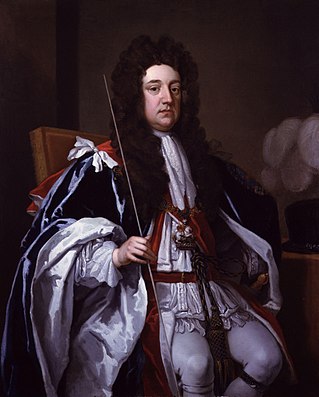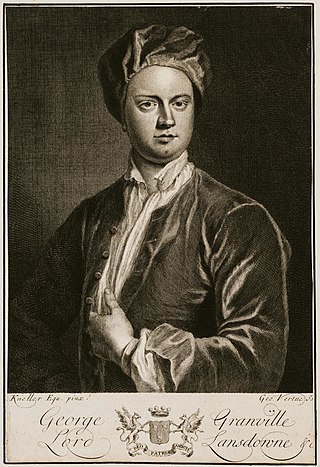Related Research Articles

Francis Godolphin Osborne, 5th Duke of Leeds,, styled Marquess of Carmarthen until 1789, was a British politician. He notably served as Foreign Secretary under William Pitt the Younger from 1783 to 1791. He also was Governor of Scilly. In 1790, he was made a Knight of the Order of the Garter. As a statesman, he is generally regarded as a failure, and his deep hostility to the newly independent United States damaged relations between the two countries.

Sidney Godolphin, 1st Earl of Godolphin, was an English Tory politician and peer. He was a Privy Councillor and Secretary of State for the Northern Department before he attained real power as First Lord of the Treasury. He was instrumental in negotiating and passing the Acts of Union 1707 with Scotland, which created the Kingdom of Great Britain. He had many other roles, including that of Governor of Scilly.

The titles of Earl of Hertford and Marquess of Hertford have been created several times in the peerages of England and Great Britain.

Earl of Cardigan is a title in the Peerage of England, currently held by the Marquesses of Ailesbury, and used as a courtesy title by the heir apparent to that Marquessate, currently David Brudenell-Bruce, Earl of Cardigan, son of the 8th Marquess. The Brudenell family descends from Sir Robert Brudenell, Chief Justice of the Common Pleas from 1520 to 1530. His great-grandson, Sir Thomas Brudenell, was created a Baronet in the Baronetage of England, styled "of Deene in the County of Northampton", on 29 June 1611. On 26 February 1628, he was raised to the Peerage of England as Baron Brudenell, of Stanton Wyvill in the County of Leicester, and on 20 April 1661 he was further honoured when he was made Earl of Cardigan, also in the Peerage of England. On his death, the titles passed to his son, Robert, the 2nd Earl, and on the 2nd Earl's death to his grandson, George, the 3rd Earl, the 2nd Earl's only son, Francis, Lord Brudenell, having predeceased his father.
Baron Darcy de Knayth is a title in the Peerage of England. It was created in 1332 for John Darcy with remainder to his heirs general, allowing daughters to inherit.

Earl of Chichester is a title that has been created three times, twice in the Peerage of England and once in the Peerage of the United Kingdom. The current title was created in the Peerage of the United Kingdom in 1801 for Thomas Pelham, 2nd Baron Pelham of Stanmer.

Duke of Leeds was a title in the Peerage of England. It was created in 1694 for the prominent statesman Thomas Osborne, 1st Marquess of Carmarthen, who had been one of the Immortal Seven in the Revolution of 1688. He had already succeeded as 2nd Baronet, of Kiveton (1647) and been created Viscount Osborne, of Dunblane (1673), Baron Osborne, of Kiveton in the County of York and Viscount Latimer, of Danby in the County of York, Earl of Danby, in the County of York (1674), and Marquess of Carmarthen (1689). All these titles were in the Peerage of England, except for the viscountcy of Osborne, which was in the Peerage of Scotland. He resigned the latter title in favour of his son in 1673. The Earldom of Danby was a revival of the title held by his great-uncle, Henry Danvers, 1st Earl of Danby.

Earl of Bath was a title that was created five times in British history, three times in the Peerage of England, once in the Peerage of Great Britain and once in the Peerage of the United Kingdom. It is now extinct.

Baron Montagu of Boughton is a British title which has been created twice for members of the Noble House of Montagu. First created in 1621, in the Peerage of England, for Sir Edward Montagu, eldest son of Sir Edward Montagu of Boughton and grandson of another Sir Edward Montagu who had been Lord Chief Justice during the reign of Henry VIII. He was also the brother of Henry Montagu, later created Earl of Manchester, and of Sidney Montagu, ancestor of the Earls of Sandwich.

Earl of Godolphin was a title in the Peerage of England. It was created in 1706 for Sidney Godolphin, 1st Baron Godolphin, the Lord High Treasurer. At the same time, he was created Viscount Rialton. In 1684 he had already been created Baron Godolphin, of Rialton, also in the Peerage of England. He was a leading politician of the late seventeenth and early eighteenth centuries, a Knight of the Garter and Governor of Scilly. Upon his death in 1712, his titles passed to his only child, Francis.

George William Frederick Osborne, 6th Duke of Leeds,, styled Earl of Danby until 1789 and Marquess of Carmarthen from 1789 to 1799, was a British peer and politician. He served as Master of the Horse between 1827 and 1830. He also was Governor of Scilly.

George Montagu, Duke of Montagu KG, PC, FRS styled Lord Brudenell until 1732 and known as the Earl of Cardigan between 1732 and 1766, was a British peer.

George Granville, 1st Baron Lansdowne PC, of Stowe, Cornwall, was an English Tory politician who sat in the English and British House of Commons from 1702 until 1712, when he was raised to the peerage as Baron Lansdown and sat in the House of Lords. He was Secretary at War during the Harley administration from 1710 to 1712. He was also a noted poet and made a name for himself with verses composed on the visit of Mary of Modena, then Duchess of York, while he was at Cambridge in 1677. He was also a playwright, following in the style of John Dryden.

Francis Godolphin, 2nd Earl of Godolphin,, styled Viscount Rialton from 1706 to 1712, was an English courtier and politician who sat in the English and British House of Commons between 1695 and 1712, when he succeeded to the peerage as Earl of Godolphin. Initially a Tory, he modified his views when his father headed the Administration in 1702 and was eventually a Whig. He was a philanthropist and one of the founding governors of the Foundling Hospital in 1739.
Francis Godolphin Osborne, 1st Baron Godolphin, styled Lord Francis Osborne from 1789 to 1832, was a British politician.

Francis George Godolphin D'Arcy D'Arcy-Osborne, 7th Duke of Leeds, styled Earl of Danby from birth until 1799 and Marquess of Carmarthen from 1799 until 1838, was a British peer and politician.
Francis Godolphin is the name of:

George Godolphin Osborne, 8th Duke of Leeds was a British peer.

William Godolphin, Marquess of Blandford, styled as Viscount Rialton until 1722, was an English nobleman and politician who sat in the House of Commons between 1720 and 1731.